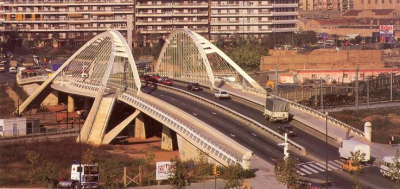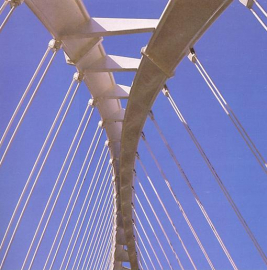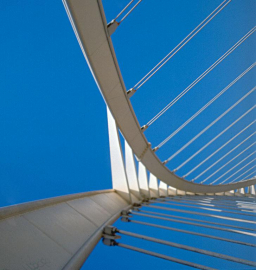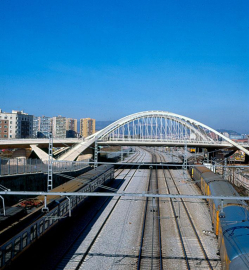Bac de Roda - Felip II Bridge
Barcelona's planning authority commissioned the Bach de Roda Bridge to connect the area of Sant Andreu in the north to Sant Martí in the south, on the fringes of the Pla Cerdà.
This initiative, which was part of a scheme to revitalize two impoverished areas of the city, also included the construction of a new railway station close by. The wide, flat embankments of the railway cutting were to be transformed into a continuation of the Parc del Clot, thus creating one of the most expansive green areas in the city.
By connecting Felipe II Street and Bach de Roda Street, the bridge permits direct access to the sea and converts marginal areas of the city into a public park. The bridge is now an urban landmark integrated into the cityscape. Measuring 128 meters (420 feet) in overall length, the bridge is composed of three parts: a central segment, 45-meter-long (148 feet), above the railway line, and two lateral segments, 25-meter-long (82 feet), which pass through the park. The lateral segments are connected to the green areas by four staircases, which rise from the bases of the inclined arches, above track level, to guarantee visual continuity.
The structural elements of the bridge are foundations on piles, supports, superstructure, arches, and central-beams. The concrete uprights, with a sinusoidal plan in the central part, are formed by barrier walls inclined forward. The intermediate supports, about 4 meters (13 feet) in height with a truncated cone form, transmit the vertical forces to the foundations and stabilize the bridge laterally. The central pendular supports are monolithic granite columns. The superstructure of the bridge is composed of hollow longitudinal elements that support the traffic lanes with transverse steel beams, while the pedestrian sidewalks widen, at the center, to form two overhangs supported by the structural elements and by the central arches.
A vertical arch beam, connected to the bridge-beam by means of tie-rods, characterizes the central segment, stabilized by lateral steel arches inclined at a 60-degree angle. Not only does this device of angled, leaning arches eliminate the need for a truss between the main arches, but it also allows for the creation of a public space within the arches, making the bridge a place in itself, rather than a mere conduit between places. The stairs, which provide access to parks on either side of the bridge, follow the profile of the supporting abutments, leading people up to the pedestrian areas of the bridge.







